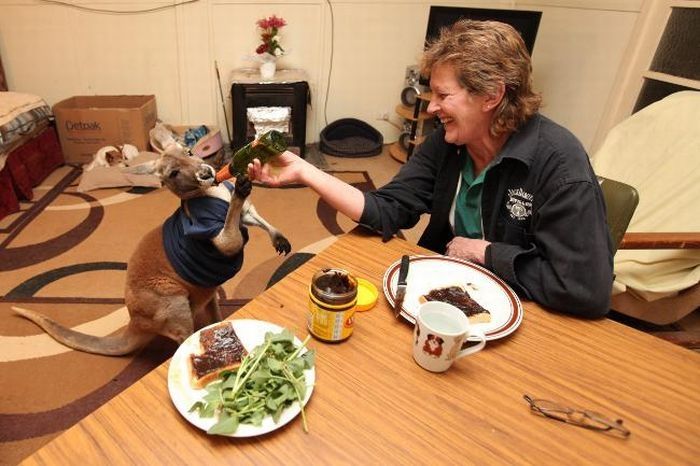|
|
Beemer, Pet Kangaroo
|
- The western grey kangaroo (Macropus fuliginosus) is slightly smaller again at about 54 kg (119 lb) for a large male. It is found in the southern part of Western Australia, South Australia near the coast, and the Darling River basin. The highest population densities occur in the western Riverina district of New South Wales and in western areas of the Nullarbor Plain in Western Australia. Populations may have declined, particularly in agricultural areas. The species has a high tolerance to the plant toxin sodium fluoroacetate, which indicates a possible origin from the south-west region of Australia.
- The antilopine kangaroo (Macropus antilopinus) is, essentially, the far-northern equivalent of the eastern and western grey kangaroos. It is sometimes referred to as the ‘Antilopine Wallaroo,’ but in behaviour and habitat it is more similar to Red and grey kangaroos. Like them, it is a creature of the grassy plains and woodlands, and gregarious. Their name comes from their fur, which is similar in colour and texture to that of antelopes. Characteristically, the noses of males swell behind the nostrils. This enlarges nasal passages and allows them to release more heat in hot and humid climates.
In addition, there are about 50 smaller macropods closely related to the kangaroo in the family Macropodidae. Kangaroos and other macropods share a common ancestor with Phalangeridae from the mid-Miocene. This ancestor was likely arboreal and lived in the canopies of the extensive forests that covered most of Australia at that time, when the climate was much wetter, and fed on leaves and stems. From the late Miocene though the Pliocene and into the Pleistocene the climate got drier which lead to a decline of forests and expansion of grasslands. At this time there was a radiation of macropodids characterised by enlarged body size and adaptation to the low quality grass diet with the development of foregut fermentation. The most numerous early macropods, the Balbaridae and Bulungmayinae, went extinct in the late Miocene around 5–10 mya. There is dispute over the relationships of the two groups to modern kangaroos and rat kangaroos. Some argue that the balbarines were the ancestors of rat kangaroos and the bulungmayines were the ancestors of kangaroos. while others hold the contrary view.
The middle to late bulungmayines, Gungaroo and Wanburoo lacked digit 1 of the hind foot and digits 2 and 3 were reduced and partly under the large digit 4, much like the modern kangaroo foot. This would indicate that they were bipedal. In addition their ankle bones had an articulation that would have prohibited much lateral movements, an adaptation for bipedal hopping. Species related to the modern grey kangaroos and wallaroos begin to appear in the Pliocene. The red kangaroo appears to be the most recently evolved kangaroo with its fossil record not going back beyond the Pleistocene period, 1–2 mya.
|
|









